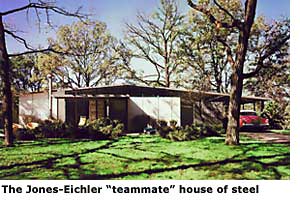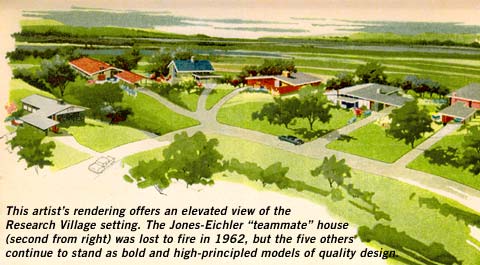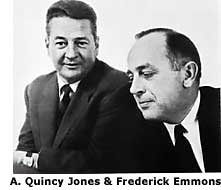U.S. Gypsum's 'Research Village'
 Predating two other Joseph Eichler ventures into steel—the X-100 in the Highlands of San Mateo and the All-Steel Builders Home of Palo Alto—was U.S. Gypsum's Research Village. The community of six moderately priced homes, each constructed by a different architect/builder team representing six distinct regions of the United States, was carved out of a forest in 1954 in the unincorporated subdivision of Barrington Woods, in Cook County, Illinois.
Predating two other Joseph Eichler ventures into steel—the X-100 in the Highlands of San Mateo and the All-Steel Builders Home of Palo Alto—was U.S. Gypsum's Research Village. The community of six moderately priced homes, each constructed by a different architect/builder team representing six distinct regions of the United States, was carved out of a forest in 1954 in the unincorporated subdivision of Barrington Woods, in Cook County, Illinois.
But the undertaking really started a few years earlier, over dinner and cocktails at Ken Hedrich's East Coast home. "My brother Ken got together with one of his very dear friends, Graham Morgan, who was heading up U.S. Gypsum; and Jack Maynard, an advertising man in charge of the USG account," recalled 73-year-old Jack Hedrich, former president and CEO of the renowned architectural photographic studio, Hedrich-Blessing, which was owned by him, Ken, and two other brothers.
The concept for Research Village developed when the three men were batting about ideas on how to encourage builders to do a better job of home design; and at the same time promote the use of U.S. Gypsum products, which numbered about 900 at the time, ranging from planks to steel roof decking. Jack Hedrich, whose company photographed the U.S. Gypsum event, lamented, "The design of most development work in the 1950s was just horrible." The slipshod nature of the industry, he explained, was such that builders would frequently commission a "nephew" who had just graduated from architectural school to put a seal of approval on an easy-to-build house with little effort put into the actual design.
In September 1952, U.S. Gypsum unveiled their revolutionary idea for Research Village at the annual directors' meeting of the National Association of Home Builders. "Leading architects and builders from different climatic regions of the country would be invited to team their talents to produce not only ideas to appeal to the home buyer, but also practical new design and construction ideas, and entirely new applications for building materials already in use," read an account in "The Story of Research Village," an article published in house by U.S. Gypsum.

An advisory panel was formed, which compiled a list of 40 of the country's leading and most imaginative residential architects, among which six where finally selected and matched with "teammate" builders. Included was the team of Jones & Emmons and J. L. Eichler & Sons, Inc., an early formation of Eichler Homes, representing the western region.
The six "laboratories" of modern architecture made their first public appearance in January 1954 with detailed scale models, renderings, and floor plans that were exhibited at the Home Builders Exposition in Chicago. A few months later, Progressive Architecture magazine proclaimed the U.S. Gypsum-nurtured project "the highlight of the 10th Annual Convention." And at the same convention the following year, thousands of delegates to the NAHB conference were bused to the tract, 30 miles northwest of the Chicago loop, to inspect the finished product. "What they saw were six houses, very different in plan and structural concept, yet presenting a handsome group appearance, built on an uneven, wooded tract of an attractive suburb," stated May 1955 coverage in Progressive Architecture.

"Of course, people walked all over the subdivision," recalled Bob Ahrens, who has lived in one of the ten ranch-style homes on the eastern section of the tract that were constructed a year before Research-Village, which followed on the west side. Ahrens felt the USG ideas were quite peculiar when he stated, "They weren't exactly what people would traditionally want—a steel house, a concrete house, and things like that." In line with Ahrens' thinking, the subdivision of 71 homes was eventually built out, mostly with conventional construction.




